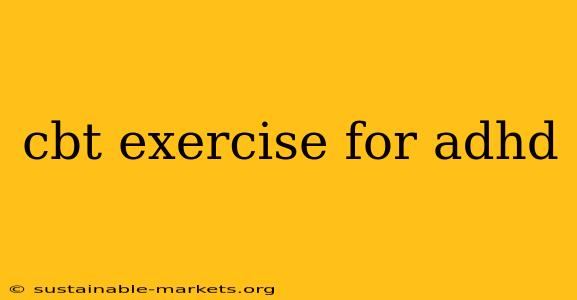Attention-Deficit/Hyperactivity Disorder (ADHD) presents unique challenges, but Cognitive Behavioral Therapy (CBT) offers powerful tools to manage symptoms and improve overall well-being. This post explores practical CBT exercises specifically designed to address common ADHD struggles. These techniques are not a replacement for professional help; they should be considered supplementary tools to support treatment from a qualified therapist or psychiatrist.
Understanding the CBT Approach to ADHD
CBT for ADHD focuses on identifying and modifying negative thought patterns and behaviors that contribute to ADHD symptoms. It emphasizes developing practical coping mechanisms and strategies to improve self-regulation, organization, and focus. The core principle is to break down overwhelming tasks into manageable steps and develop a proactive approach to managing challenges.
Effective CBT Exercises for ADHD
Here are some key CBT exercises that can be incredibly beneficial for individuals with ADHD:
1. Identifying and Challenging Negative Thoughts: Cognitive Restructuring
ADHD often brings negative self-talk, such as "I'm lazy," "I'll never get this done," or "I'm a failure." This exercise helps challenge these unhelpful thoughts:
- Identify negative thoughts: Keep a journal to track these thoughts throughout the day. Note the situation that triggered the thought and the emotional response.
- Challenge the evidence: Ask yourself: Is this thought truly accurate? What evidence supports it? What evidence contradicts it? Often, these negative thoughts are based on assumptions rather than facts.
- Develop alternative thoughts: Replace negative thoughts with more balanced and realistic ones. For example, instead of "I'm a failure," try "This task was challenging, but I can learn from my mistakes and try a different approach."
- Behavioral Experimentation: Test out your new thought patterns. If you believe a task is impossible, break it down and see if you can successfully complete smaller steps.
2. Breaking Down Tasks: Task Analysis and Prioritization
Overwhelm is a common ADHD experience. Task analysis helps manage this:
- Break it down: Divide large tasks into smaller, more manageable steps. This makes the overall goal less daunting and provides a sense of accomplishment as each step is completed.
- Prioritize tasks: Use tools like Eisenhower Matrix (urgent/important) or simply list tasks in order of importance. Focus on high-priority items first.
- Time blocking: Allocate specific time slots for each task in your schedule. This helps create structure and reduces procrastination.
3. Improving Self-Monitoring and Self-Reinforcement: Behavioral Activation
This involves tracking behaviors and rewarding positive actions:
- Track progress: Keep a record of your accomplishments, no matter how small. This provides visual reinforcement of your progress and boosts motivation.
- Reward yourself: Set up a reward system for completing tasks. Rewards should be things you genuinely enjoy.
- Self-Compassion: Acknowledge that setbacks are a normal part of the process. Practice self-compassion instead of self-criticism when you encounter challenges.
4. Mindfulness and Meditation: Reducing Impulsivity and Improving Focus
Mindfulness techniques can help improve focus and reduce impulsivity:
- Mindful breathing: Practice deep, focused breathing exercises to calm the mind and improve concentration. Even a few minutes a day can make a difference.
- Body scan meditation: Pay attention to sensations in your body without judgment. This helps increase self-awareness and reduce impulsivity.
5. Developing Coping Mechanisms for Frustration and Impulsivity: Emotional Regulation
ADHD can lead to frustration and impulsive behaviors. Developing coping mechanisms is crucial:
- Identify triggers: Recognize situations or thoughts that lead to frustration or impulsivity.
- Develop coping strategies: Create a list of healthy coping mechanisms, such as taking a break, deep breathing, or engaging in a relaxing activity.
- Practice relaxation techniques: Progressive muscle relaxation or guided imagery can help manage stress and improve emotional regulation.
Conclusion: The Power of Consistent Effort
These CBT exercises are effective tools when practiced consistently. Remember that progress takes time and patience. It's essential to be kind to yourself and celebrate your achievements along the way. While these exercises are helpful, they are most effective when integrated into a comprehensive treatment plan guided by a mental health professional. Don't hesitate to seek professional help if you're struggling with ADHD symptoms. A therapist can provide personalized guidance and support to help you develop effective coping strategies and improve your quality of life.

